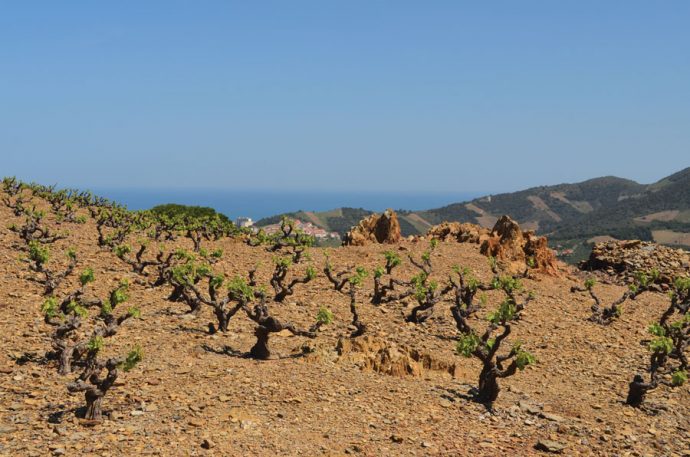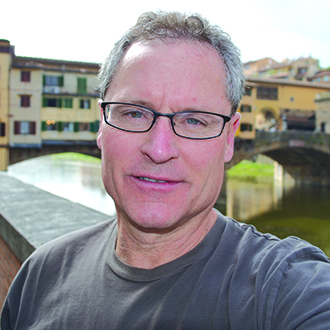I traveled recently to the center of the universe, so to speak, on a cosmic wine media trip and came back more than a little changed. Salvador Dalí was born, lived and died in France near the Roussillon capital city of Perpignan and declared the city of Perpignan, actually Perpignan’s train station, to be the “center of the universe.’ Roussillon is the largest sweet wine producing area in France. When you think of sweet wines of France, Sauternes, a sub-appellation of Bordeaux, immediately comes to mind. But Roussillon, in the South of France — nestled amid the Pyrennees mountains, the Mediterranean Sea and the Spanish border — could well be the center of the universe of sweet wine production in France.
Languedoc-Roussillon is the largest wine production area by hectares and production volume. They are usually lumped together at tastings and in stores and on wine lists. But they are two distinctly different areas. The Languedoc region has its own culture and history and language while the Roussillon wine producers are much more affiliated with Spain’s Catalan culture. Several years ago at a winery in Roussillon, the owner was telling stories about culture and language. I asked if he considered himself more French or more Catalan. He looked at me in disbelief and said, emphatically, “Catalan, bien sur.” Of course.
The region of Roussillon was passed around between French protectorates and Spanish kingdoms for generations. When all the noble marriages for acquisition of terrain and influence settled out and all the battles for dominance ended, a treaty drew the line between France and Spain. But the Catalan culture and language, although banned for centuries, persists on both sides of the border. Geographically, then, Roussillon is a narrow region defined by physical boundaries — the mountains, the sea and the border. Despite being more southerly, Roussillon is considerably higher in altitude than the Languedoc region, which makes it ideal for wine production. There are three west-to-east flowing rivers from the mountains to the sea — l’Agly, la Têt and le Tech — that have carved out valleys and rifts and ideal vineyard sites.
Banyuls and Coullioure are two steeply ascendant adjacent wine districts in Roussillon overlooking the Mediterranean, with the Maury region more to the north. We drove through these wine regions and took long walks up in the hills overlooking the sea. There the vineyards are unique. Most vineyards of the world have to figure out a solution to the weeds between the rows. Excepting the foliage on the vines, these vineyards are devoid of plant life. The ground and the surface is all rock of various types, ranging from schist to granite to iron-laden ores. They contribute flavor and a certain minerality to that overall quality known as terroir. If you pick up a small stone from a rolling river and put it in your mouth, there is an austere, stony flavor you can taste. The same thing happens with grapes. The growing medium has a distinct contribution to the ultimate flavor of the wine.
The Roussillon region makes flavorful reds and lovely whites, both with structure, texture and elegance. Despite its winemakers being known for generations as bulk-wine producers, they have learned that attention to detail matters if they want to up their game. More appropriate vine selection for the site, reducing grape yields per acre, better organic or sustainable farming practices and better winemaking skills has elevated Roussillon wines to a respectable place.
But for me the sweet wines of Roussillon, got my attention, along with the process are known as vin doux naturels or sweet natural wines. These wines are not subjected to botrytis, the fungus called the noble rot for which Sauternes is known. Nor is sugar added to contribute to the sweetness. The grapes are picked, pressed and fermented and, at a point in the process, the fermentation is arrested by adding a grape-derived distilled spirit. This keeps some of the sugars in the juice and the added spirit bumps up the alcohol levels to 15.5 percent alcohol by volume. This is considerably less alcohol than the Ports and Madeiras of Portugal and the sherries of Jerez, Spain. The regional rules require certain percentages of grapes and minimum oak aging times to get the better titles such as Grand Vin.
The vin doux naturels and the Rivesaltes wines made from Grenache Blanc, Noir or Gris, and then brought to a wonderful level through judicious oak aging are worth looking for. You will likely have to special order them as I haven’t yet found them in the U.S., but they can be ordered. A few noteworthy producers I found are Domaine Cazes, Domaine Singla, Domaine Villeneuve, Gerard Bertrand, Domaine Dom Brial and Château Les Pins. Some of these wines are intentionally oxidized to give a hint of sherry-type flavors. This trip to the Roussillon showed me these impressive wines can now stand alone.
Order up some and take a journey.
Write me at doug@dougpaulding.com.


